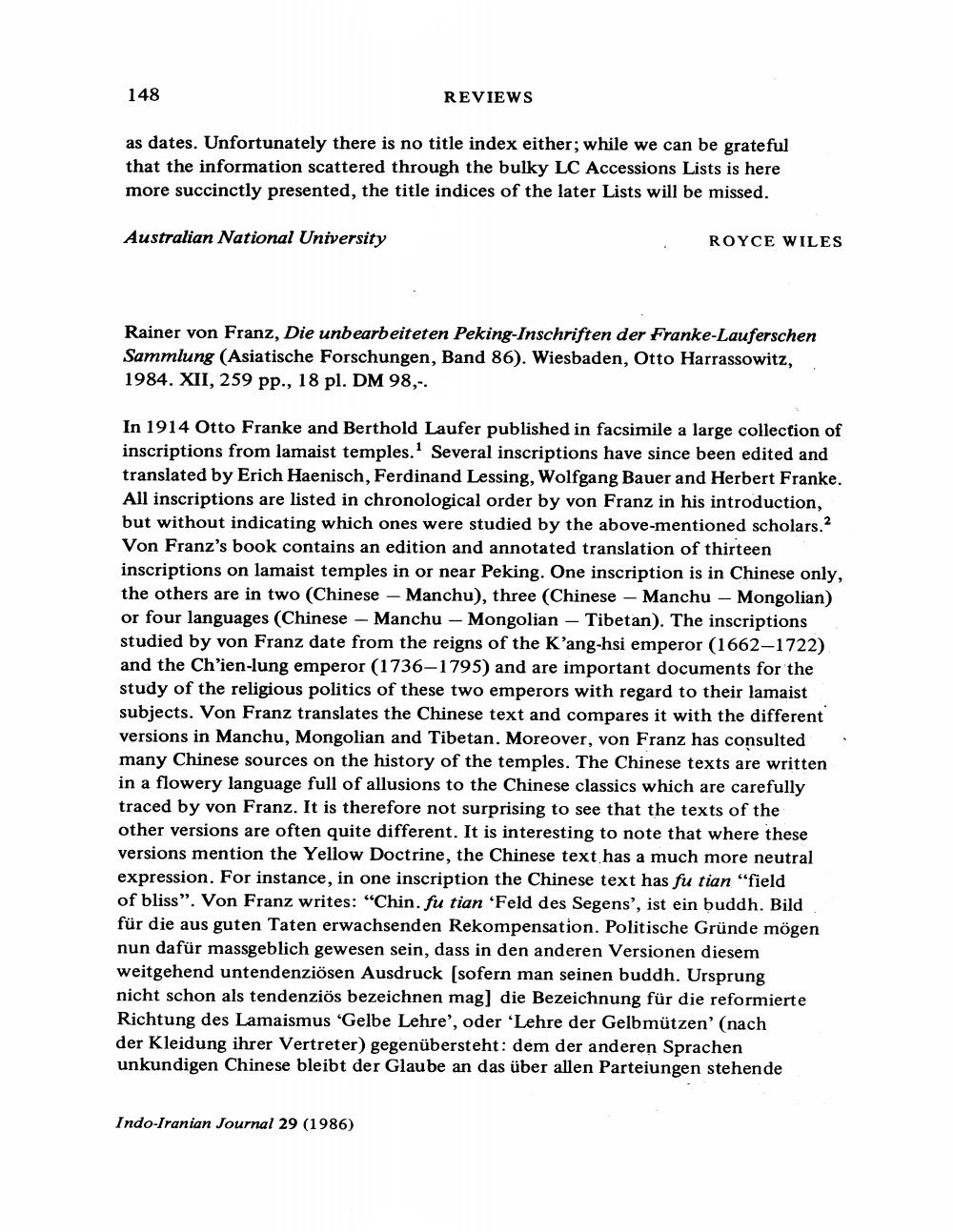Book Title: Reviews Of Diffeent Books Author(s): Publisher: View full book textPage 2
________________ 148 REVIEWS as dates. Unfortunately there is no title index either; while we can be grateful that the information scattered through the bulky LC Accessions Lists is here more succinctly presented, the title indices of the later Lists will be missed. Australian National University ROYCE WILES Rainer von Franz, Die unbearbeiteten Peking-Inschriften der Franke-Lauferschen Sammlung (Asiatische Forschungen, Band 86). Wiesbaden, Otto Harrassowitz, 1984. XII, 259 pp., 18 pl. DM 98,-. In 1914 Otto Franke and Berthold Laufer published in facsimile a large collection of inscriptions from lamaist temples. Several inscriptions have since been edited and translated by Erich Haenisch, Ferdinand Lessing, Wolfgang Bauer and Herbert Franke. All inscriptions are listed in chronological order by von Franz in his introduction, but without indicating which ones were studied by the above-mentioned scholars.? Von Franz's book contains an edition and annotated translation of thirteen inscriptions on lamaist temples in or near Peking. One inscription is in Chinese only, the others are in two (Chinese - Manchu), three (Chinese - Manchu - Mongolian) or four languages (Chinese - Manchu -- Mongolian - Tibetan). The inscriptions studied by von Franz date from the reigns of the K'ang-hsi emperor (1662-1722) and the Ch'ien-lung emperor (1736-1795) and are important documents for the study of the religious politics of these two emperors with regard to their lamaist subjects. Von Franz translates the Chinese text and compares it with the different versions in Manchu, Mongolian and Tibetan. Moreover, von Franz has consulted i many Chinese sources on the history of the temples. The Chinese texts are written in a flowery language full of allusions to the Chinese classics which are carefully traced by von Franz. It is therefore not surprising to see that the texts of the other versions are often quite different. It is interesting to note that where these versions mention the Yellow Doctrine, the Chinese text has a much more neutral expression. For instance, in one inscription the Chinese text has fu tian "field of bliss". Von Franz writes: "Chin. fu tian 'Feld des Segens', ist ein buddh. Bild fur die aus guten Taten erwachsenden Rekompensation. Politische Grunde mogen nun dafur massgeblich gewesen sein, dass in den anderen Versionen diesem weitgehend untendenziosen Ausdruck (sofern man seinen buddh. Ursprung nicht schon als tendenzios bezeichnen mag) die Bezeichnung fur die reformierte Richtung des Lamaismus 'Gelbe Lehre', oder 'Lehre der Gelbmutzen' (nach der Kleidung ihrer Vertreter) gegenubersteht: dem der anderen Sprachen unkundigen Chinese bleibt der Glaube an das uber allen Parteiungen stehende Indo-Iranian Journal 29 (1986)Page Navigation
1 2 3 4 5 6 7 8
